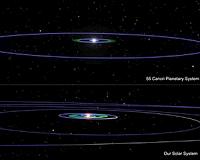 |
Paris (AFP) May 11, 2011 Scientists on Wednesday said they could explain why heat-seared giant planets in other solar systems can mysteriously orbit their star the "wrong" way. These space oddities belong to a class of planets known as hot Jupiters -- gassy giants that are the size of our own Jupiter but encircle their sun at sometimes scorchingly close distances. What has bedevilled astronomers is the discovery that in some star systems, the host star spins one way while a hot Jupiter can orbit in the opposite direction. This throws down a challenge to the yardstick of celestial mechanics, which is our solar system. In our neighbourhood, all the planets trot obediently around the Sun in the same direction as its own spin. (The solar "day" -- the amount of time it takes for the Sun to complete one revolution at its equator -- is 26 days.) "We had thought our solar system was typical in the Universe, but from day one, everything has looked weird in the extrasolar planetary systems. That makes us the oddball really," said Frederic Rasio, an astrophysicist at Northwestern University in Illinois. In a study published by the science journal Nature, Rasio's team devised a model that, they believe, explains this contra-rotation conundrum. The researchers start with the theoretical basis of a star that is similar in size to the Sun. It has a system comprising two large planets that lie relatively close to each other and, initially, are located at a long range from the star. Each orbit the star in the "right" direction. The idea for the model is that a combination of forces -- a gravitational coupling between the two planets as they near each other, and powerful tides on the innermost planet -- causes this cosy planetary system to break up. Over a very long time, the inner planet starts to shift into an eccentric needle-shaped orbit, which gradually shrinks. The planet is hauled in close to the star, creating the hot Jupiter, and in the process its orbit can flip. But this is something that happens only in about a quarter of hot Jupiter systems that have been observed so far, says the paper. Until now, one of the theories for explaining the flip was that it occurred in binary systems, where there are two stars, one of which exerted a gravitational tug that caused the planet to reverse course. More than 500 extrasolar planets have been recorded since the first was detected in 1995. One of the pioneers in this discipline, Swiss astronomer Didier Queloz, said that as techniques for planet-spotting improved, awareness was growing of the broad range of solar systems compared with our own, neat setup. "Right now, the notion that solar systems are like ours is completely falling apart," Queloz, who did not take part in the new study, said in an interview with AFP. "We are just one type of of solar system among an enormous diversity of planetary orbits and possibilities."
Share This Article With Planet Earth
Related Links Lands Beyond Beyond - extra solar planets - news and science Life Beyond Earth
 An Earth as Dense as Lead
An Earth as Dense as LeadMoffett Field CA (SPX) May 02, 2011 A planet that we thought we knew turns out to be rather different than first suspected. A revised view comes from new data released by an international team of astronomers, who made their observations of the planet "55 Cancri e" based on calculations by Harvard graduate student Rebekah Dawson (Harvard-Smithsonian Center for Astrophysics). Dawson worked with Daniel Fabrycky (now at the Univ ... read more |
|
| The content herein, unless otherwise known to be public domain, are Copyright 1995-2010 - SpaceDaily. AFP and UPI Wire Stories are copyright Agence France-Presse and United Press International. ESA Portal Reports are copyright European Space Agency. All NASA sourced material is public domain. Additional copyrights may apply in whole or part to other bona fide parties. Advertising does not imply endorsement,agreement or approval of any opinions, statements or information provided by SpaceDaily on any Web page published or hosted by SpaceDaily. Privacy Statement |